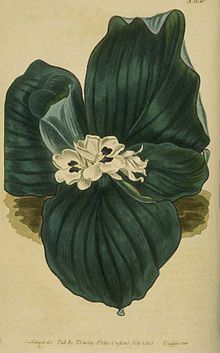Kaempferia galanga
This article needs additional citations for verification. (July 2009) |
| Kaempferia galanga | |
|---|---|

| |
| Drawing from an 1805 issue of The Botanical Magazine | |
| Scientific classification | |
| Kingdom: | Plantae |
| Clade: | Tracheophytes |
| Clade: | Angiosperms |
| Clade: | Monocots |
| Clade: | Commelinids |
| Order: | Zingiberales |
| Family: | Zingiberaceae |
| Genus: | Kaempferia |
| Species: | K. galanga
|
| Binomial name | |
| Kaempferia galanga | |
Kaempferia galanga, commonly known as kencur, aromatic ginger, sand ginger, cutcherry, is a monocotyledonous plant in the ginger family, and one of four plants called galangal. It is found primarily in open areas in Indonesia, southern China, Taiwan, Cambodia, and India, but is also widely cultivated throughout Southeast Asia.
Culinary and medical use
Kaempferia galanga is used as a spice in cooking in Indonesia, where it is called kencur ('cekur' in Malaysia), and especially in Javanese and Balinese cuisines. Beras kencur, which combines dried K. galanga powder with rice flour, is a particularly popular jamu herbal drink. Its leaves are also used in the Malay rice dish, nasi ulam.
Unlike the similar
Similar species
K. galanga is differentiated from other galangals by the absence of stem and dark brown, rounded rhizomes, while the other varieties all have stems and pale rosebrown rhizomes.[
- Alpinia galanga[3]
- Alpinia zerumbet[4]
- Curcuma longa[4]
- Etlingera elatior[3][4]
- Etlingera maingayi[3]
- Etlingera fulgens[3][5]
- Kaempferia angustifolia[6]
- Kaempferia rotunda[6][7]
- Zingiber cassumunar[7][8]
- Zingiber officinale[9]
Chemical constituents
The rhizomes of aromatic ginger have been reported to contain
- Terpenoids (26)
- Phenolics (15)
- Polysaccharides (15)
- Flavonoids (3)
- FattyAcids and Esters (11)
- DiarylHeptanoids (6)
Insecticidal research
Extracts of the plant kill larvae of several species of mosquito including some that are disease vectors.[11][12] As a result of these findings, research is underway to evaluate the plant extract's use as an insect repellent, with preliminary findings suggesting it is not an irritant to the skin of rats.[13]
Extracts and essential oils

The rhizomes of the plant, which contain essential oils, have been used in traditional Chinese medicine as a decoction or powder. Its alcoholic maceration has also been applied as liniment for rheumatism.[13] The extract causes central nervous system depression, a decrease in motor activity, and a decrease in respiratory rate.[14]
The decoctions and the sap of the leaves may have hallucinogenic properties, which may be due to unidentified chemical components of the plant’s essential oil fraction.[15]
A purified extract of K. galanga and polyester-8 stabilize the UV-absorptive properties of sunscreen combinations containing avobenzone.[16]
Aroma attributes
- Borneol[17]
- 1,8-Cineole[17]
- Ethyl cinnamate[17], [18]
- Ethyl p-methoxycinnamate[17][19]
- Gamma-car-3-ene[17]
- Pentadecane[17]
See also
References
- ^ ISBN 978-0-88192-743-6.
- ^
Wu, Delin; Larsen, Kai (2000). "Kaempferia galanga". In Wu, Z. Y.; Raven, P.H.; Hong, D.Y. (ed.). Flora of China. Vol. 22. Beijing: Science Press; St. Louis: Missouri Botanical Garden Press. p. 74. Retrieved 16 July 2007.
{{cite book}}: CS1 maint: multiple names: authors list (link) - ^ .
- ^ .
- .
- ^ doi:10.1002/ffj.1284.
- ^ .
- S2CID 206424932.
- PMID 16169024.
- PMID 34737693.
- PMID 18324612.
- ^ Kim N.-J., Byun S.-G., Cho J.-E., Chung K., Ahn Y.-J. "Larvicidal activity of Kaempferia galanga rhizome phenylpropanoids towards three mosquito species." Pest Management Science 2008 64:8 (857-862)
- ^ PMID 15013202.
- PMID 15013202.
- ISBN 978-1-58112-404-0.
- ^ Gonzalez A., Gaenzler F. "Photostability of sunscreen combinations containing avobenzone exposed to natural and artificial ultraviolet light." Journal of the American Academy of Dermatology 2011 64:2 SUPPL. 1 (AB30)
- ^ .
- PMID 16360934.
- PMID 18761077.
External links
 Media related to Kaempferia galanga at Wikimedia Commons
Media related to Kaempferia galanga at Wikimedia Commons- Use in Andalusian Cooking
- Account at Gernot Katzer's Spice Pages
